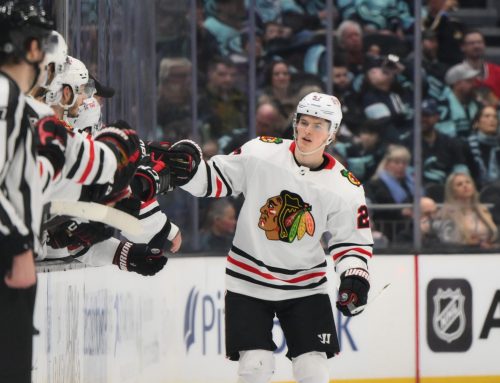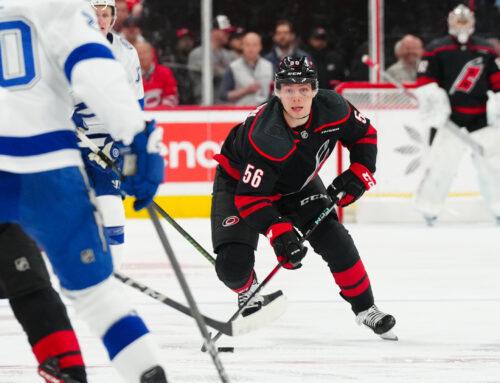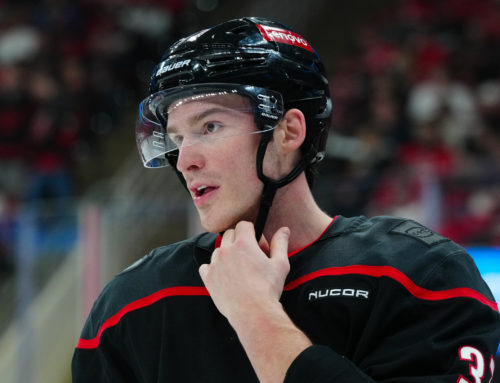It was the first day of training camp and as I mentioned in my Tuesday Ramblings, keeping track of where players are slotted is important. Of course, things will change, but it helps us gain insight into what the coaching staff thinks of their players. Let's go through them quickly:
- Columbus had Gaudreau-Jenner-Johnson on one line and Texier-Fantilli-Laine on another. We may be staring down Fantilli as the 2C out of the gate. (Source)
- New Jersey's newest Devil, Tyler Toffoli, was with Jack Hughes and Jesper Bratt. Forgotten prospect Alex Holtz was lined up with Nico Hischier and Timo Meier, which sounds incredibly rad to me. (Source)
- Detroit predictably loaded their top line with Alex DeBrincat joining Dylan Larkin and Lucas Raymond. My David Perron best ball shares are in shambles. (Source)
- Seth Jarvis was indeed with Sebastian Aho, as was new Hurricane Michael Bunting. Andrei Svechnikov was at camp and skating with Jesperi Kotkaniemi and Martin Necas, though Scevch was in a non-contact jersey. Still a good sign, however. Carolina's first power play run through also had both Brent Burns and Tony DeAngelo in a 3F/2D setup, along with Aho, Jarvis, and Svechnikov. (Source)
- Ryan Hartman was back as Minnesota's top-line centre, so Marco Rossi Watch begins anew as he was on the third line with Marcus Foligno. (Source)
- Interestingly, Washington had Anthony Mantha line up with the Backstrom-Ovechkin duo. That is something to watch. (Source)
- The Capitals also had Connor McMichael skating with TJ Oshie, so it seems he’ll get a real chance to crack the opening night roster. (Source)
- Zach Benson was on Buffalo's top line with Jeff Skinner and Tage Thompson, which is a nice vote of confidence for the 2023 draftee. (Source)
- As expected, Jonathan Drouin was alongside Nathan MacKinnon in camp with Colorado boasting a brand-new third line of Wood-Colton-Tatar. (Source)
- New Calgary Flame Yegor Sharangovich was on the top line with Elias Lindholm and Jonathan Huberdeau. (Source)
- As expected, with Matthew Knies next to John Tavares, William Nylander is starting out as 3C for Toronto. (Source)
- Claude Giroux was on the top line for Ottawa with their dynamic duo. If that keeps up, it's not great news for Drake Batherson. For posterity, the Batherson-Norris duo had Vladimir Tarasenko on their left side. (Source)
- Vegas ran back the line of Howden-Stephenson-Stone that was so good for them down the stretch last season. (Source)
- Connor Brown was seen next to Edmonton's other Connor, and Brown is someone that could have some very sneaky fantasy value even if he's not on the top PP unit. (Source)
- San Jose had Filip Zadina skating with Tomas Hertl, so the former Red Wings prospect is going to get a real chance to make his mark, it seems. (Source)
- San Jose also announced that Logan Couture will be out indefinitely with a lower-body injury. The only other real detail was that it was something from the offseason that progressively got worse. (Source)
- Winnipeg ran a second line of Ehlers-Perfetti-Niederreiter as they try and get Perfetti acclimated to second-line centre duties. (Source)
*
In a quick update on Buffalo's Jack Quinn, their general manager Kevyn Adams had this to say:
Let's hope there are no setbacks.
Staying with Buffalo, Adams said the injury Matt Savoie suffered at rookie camp wasn't too severe, but he's week-to-week, so pencil him as doubtful to make the team out of camp. That is just my guess so we'll have to see what happens.
They had a couple interesting lines at the first day of camp, other than what was noted above:
This is where it’s nice to have a bevy of good prospects. A couple of them will pan out and be useful, and probably as soon as this season.
*
An update on Oliver Kylington:
He was someone I thought would really help the team out but whatever this issue happens to be is still lingering. That seems like bad news but we'll have to wait to hear more.
*
Taylor Hall was not on the ice for Chicago, but it appears he'll be on the top line with Connor Bedard. The third man, for now, looks to be Tyler Johnson.
*
In yesterday's Ramblings, we reviewed some players I believe are on the cusp of a breakout. They are younger players that may be in line for an improvement in line mate quality, more (or better) power play time, or otherwise just a sizable increase in minutes played.
To continue the theme, I want to look at some players that have already had their breakout, and what their future may hold. These aren't young players with several good-to-great seasons already, like Brady Tkachuk or Jordan Kyrou, but rather young players with less of a track record. To do this, I am going to compare what they did in a variety of metrics to other players of a similar age in years gone by – things like expected goal share, expected goals for/against, goals for/against, and points or shots per 60 minutes. This higher scoring era of the NHL may skew things, so it's more of just a guideline than a hard-and-fast prediction of the future.
Unlike most days, a lot of today's data will be directly from Evolving Hockey, with Frozen Tools, Natural Stat Trick, and AllThreeZones supplementing.
(Note: expected goals metrics from the last couple seasons are a bit different than they were even 5-6 years ago, but it's all we have right now.)
Alright, let's get to it.
Often, a team's rebuild is turbo-charged when players that weren't expected to be great end up being great early in their careers, or improve significantly late in their development. Buffalo's top two centres both fit this bill and it's how the team ended up adding 16 points in the standings from 2021-22 to 2022-23.
It isn't that Dylan Cozens wasn't expected to be a good player, it's that he turned into a good second-line centre by the second half of his age-20 season, fully breaking out in his age-21 year. When I looked at pivots that had similar seasons at Cozens' age, two names came up:

Off the top, we can probably eschew Steven Stamkos. His production rates were much, much higher than that of Cozens, and his goal share puts him in another category entirely. It is interesting to see Jack Eichel's name here considering, well, you know.
Eichel showed up in the NHL and was immediately thrust into a top role, playing over 19 minutes a night as a rookie. That differs him from Cozens as well, but there are only so many comparable players to work with. A famous policeman once said: I don't get points for being an idealist, I have to do the best I can with what I have.
What stands out about Cozens is his improvement. Over his three years, these following stats have increased every season:
- Points/60
- Power play points/60
- Shots/60
- Individual Points Percentage (% of team goals scored where the player registers a point)
- Goal share
- Expected Goal share
- Scoring chances per minute
- Assists on teammate scoring chances per minute
This just seems to be a true ascension of a young centre that would probably be the team's top middle-man of the future had it not been for Tage Thompson's own breakout. It may seem like an impediment, but the NHL is littered with success cases of teams having two high-end offensive centres. It is kind of scary to think about what this 1-2 punch will look like in a couple years. Cozens is a budding point-per-game player.
This is a case where the team and the player's style are factors. The new NHL is much, much more focused on creating quality scoring chances than they had been before 2019-20, and it's why some young players seem to thrive but also have very poor on-ice metrics. The compounding problem for Trevor Zegras is that Anaheim has been god-awful in his three seasons and that does not do him any favours.
Because of the way Zegras plays – much more concerned with creating quality scoring chances than anything else – it was hard to find a comparable player. I didn't find a centre, which wasn't overly surprising, but I did find a very-good-but-not-quite-elite winger that was close enough (not sure why he’s listed as a centre here):

It might seem like a slap in the face to Zegras, Ducks fans, and fantasy managers to compare him to a guy that hasn't reached 30 goals or 70 points in a decade but hear me out.
Eberle was very, very productive early in his career. That points/60 minutes rate in the graphic above, at the time, was similar to teammate Taylor Hall, and in the range of guys like John Tavares, Marian Hossa, and Jamie Benn. The problem is Edmonton was quite a bad team in the mid-2010s and he didn't have much overlap with Connor McDavid – Eberle spent less than 37% of his 5-on-5 time alongside McDavid in their two seasons together. After his Edmonton tenure, he went to the New York Islanders where almost no one thrives offensively, which speaks to how good Tavares was in those seasons.
I have no issues projecting Zegras as a top-producing centre moving forward, but he'll need a much better team around him before he really starts scratching his fantasy upside. How their younger players progress over the next couple seasons will inform us to just how high Zegras can go.
Caufield hasn't had a true breakout season yet, but he has scored 48 goals in 83 games since Martin St. Louis took over as coach, and that's good enough for this list.
One thing St. Louis did was turn the team into one that really seeks out prime scoring areas/plays, similar to what was mentioned in the section on Zegras. The easiest way to show that is to show where Montreal shot from when Nick Suzuki was on the ice in the Bubble 2021 season (from HockeyViz):

And where they shot from with Caufield and Suzuki on the ice in 2022-23:

This is a team that went from funneling pucks to the middle, looking for deflections and rebounds, to one that is looking to set up high-percentage scoring chances with seam passes. Considering the Habs scored 50% more often (literally) with Caufield/Suzuki on the ice in 2022-23 than Suzuki alone in 2020, it seems like it's working.
To that end, we had to dig deep for guys with comparable seasons to Caufield, but we found two names. One name seems to fit Caufield's profile just fine, and the other is a guy who was the complete opposite of Caufield in terms of play style:

With the Montreal winger's injuries, the sample size is much smaller, but Kyle Connor does seem like a good comp for him. It is someone who can score a pile of goals and loves to shoot but may not be a great playmaker and has some defensive issues to work through. All the same, if the Habs get a winger who can score at least 30 goals with regularity, and often push for 40 goals, they'll be happy, and so will fantasy managers.
One of my flaws as a hockey analyst is I sometimes get impatient with young players. Generally speaking, high-end rookies/sophomores show early on that they'll be elite players; even aside from generational talents like Auston Matthews or Connor McDavid, it didn't take long for guys like Jack Hughes, Tim Stützle, and Andrei Svechnikov to show flashes of their upside. Lucas Raymond already has 40 goals and 102 points in 156 games, and he only turned 21 in the spring. I saw some measures that were not very favourable to him, though, and it made me wonder if he was just being carried by Dylan Larkin.
Maybe he was carried by Larkin, but we can hardly blame a 19- and 20-year-old winger for doing so. It is also why I do exercises like this, to see if there are any other successful players who are great now, and had good production numbers early in their careers, but poor metrics otherwise. One name came up:

They aren't exactly the same player – Jesper Bratt had better playmaking metrics at that age – but that seems like a fair comparison. It took Bratt three, maybe four years to really start showing what he was capable of, and neither was very good at 5-on-5 early in their careers. This is the path forward for Raymond and if he follows Bratt's development, this will be the season where Raymond starts showing more involvement at 5-on-5, be it with playmaking or transition work, before a real breakout a season from now. We will find out soon enough.
(NOTE: this was written before we got news about his lingering injury. I decided to keep it in just to talk about his upside.)
Though he's a little older, I wanted to include Oliver Kylington because he's returning to the NHL this season following a year-long layoff due to personal reasons. It was a shame, because his 2021-22 season was a breakout for him, showing very good metrics and having an even strength points rate in line with names like Zach Werenski and Charlie McAvoy. Those aren't his comparable names, however. This is the comparable that showed up:

It isn't fair to compare Kylington to Dougie Hamilton because the latter is a much heavier volume shooter, but there weren't many names to use here. The neat thing is that the guys I excluded for ice-time reasons were true number-1 blueliners. In other words, Kylington's profile was only found, historically speaking, among top-pair defenders. It makes a 26-year-old with one season of at least 50 games played hard to compare.
How high Kylington can go in the fantasy game is very much up in the air. Noah Hanifin only has one year left on his deal, but MacKenzie Weegar (8) and Rasmus Andersson (3) all have several years left. Kylington could end up like Bowen Byram where he's clearly very good, but there are better options in the lineup and it'll keep his ice time, and power play role, depressed. Regardless, if he can regain his 2021-22 form, the Flames are adding a potential top-pair defenceman to their second pair. In fantasy, though, if he's stuck playing 19-20 minutes with secondary power play time, he'll be in tough for value in most any format, especially where he hasn't shown much for blocked shots and hits.
The last guy I wanted to review didn't have a huge breakout year, but 32 points as a rookie 20-year-old defenceman is hard to ignore. Ottawa extended Jake Sanderson for eight years in the offseason and a lot of eyebrows were raised as to why the Senators would offer a $64M contract to a defenceman with 77 total games played. Maybe they end up regretting it, but I looked at defencemen that had similar seasons around his age, and the list is short and distinguished:

Whatever is thought of Oliver Ekman-Larsson now, he was truly one of the top defencemen of the 2010s and Kris Letang has been mostly elite for over a decade. If Sanderson ends up close to either of those careers, that contract will be a home run and he'll find a lot of success.
Like Kylington, though, the question for fantasy hockey is how high Sanderson's ceiling really is because of competition on the team. Jakob Chychrun has two years left on his contract and Thomas Chabot has five, so it could be a while before Sanderson gets a real chance at consistent top PP minutes for an entire season. He can still be productive, but there are only so many prime offensive minutes to go around, and it could be a couple years before Sanderson gets to the 25-minute mark. More importantly, it could be a half-decade before he gets a meaningful power play role. That is all assuming, of course, that he's really as good as his rookie season has shown. If he is, Ottawa has one of the best young blue lines in the league outside of Colorado. Fantasy managers may be frustrated by his usage, though, and that caps his upside for the time being.





 DAL
DAL EDM
EDM FLA
FLA CAR
CAR VAN
VAN COL
COL MTL
MTL BOS
BOS
